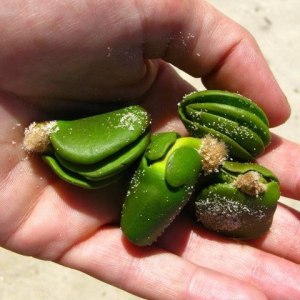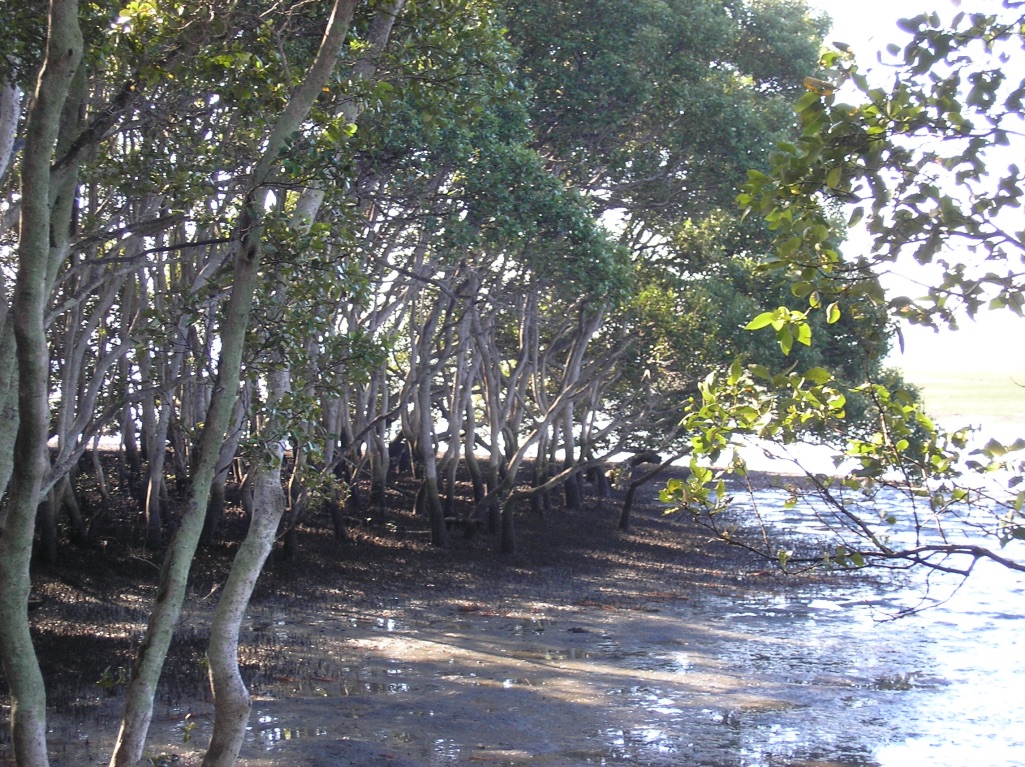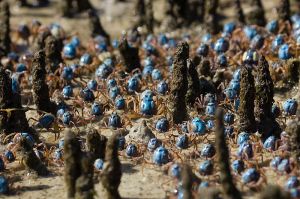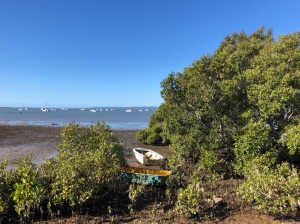At the Cod Hole, where Eudlo Creek joins the Maroochy River, I watched the soldier crabs. Scuttling across the mudflats in their hundreds, dressed in smart blue-grey uniforms, the little round crabs would feel the vibrations of my footsteps and quickly screw themselves down into the mud and disappear. If I stood still for a few minutes they would start to twist themselves back into the daylight.
My dad had bought an old weatherboard beach house on the dead-end dirt road that has since become busy Bradman Avenue. We named the house Toad Hall.
It was just upstream from where the Sunshine Motorway now crosses Maroochy River. Bradman Avenue runs upstream from Picnic Point, along the south bank of the river and over the creek, past a dragon boat club and a tavern.
The old house held out against development for years, but it’s gone now, replaced by holiday apartments. There are still some mud flats along the creek, though. You can still scoop up a soldier crab to feel it tickling your palm, trying to dig its way out of sight.
Also on the mud flats and along the banks of the river were mangroves. I collected the mangrove seedling “pencils” and used them to draw in the wet sand at the river’s edge.
I made patterns with the flower husks, like little octopuses, from which the pencils grew. Little green mangrove “books”, actually seed pods, washed up on the river’s edge too, along with sea grass fronds and scraps of pumice from ancient local volcanoes.

Only a few mangroves survive along this stretch of the river, but further upstream they still thrive across the sand and mud flats. Mangroves grow from New South Wales, right up the Queensland coast, round the Gulf of Carpentaria, across the top of Australia and throughout the tropics and sub-tropics globally, thriving in warm tidal rivers, estuaries and bays.
In many parts of the state, like Raby Bay in Cleveland and Pelican Waters at Caloundra, mangrove forests have been destroyed to make way for canal developments; but if the people, cars, concrete and bitumen disappeared, they would soon come back and resume their ancient job of filtering the mud, protecting the shoreline and pouring oxygen into the atmosphere.
Except for climate change.
Mangrove dieback in the Gulf of Carpentaria
by Lyndal Scobell, Cape York NRM
Over 7,000 hectares of coastal mangroves have died along 1000 km of coastline in the Gulf of Carpentaria. James Cook University’s Dr Norman Duke said the dieback was unprecedented, and followed a prolonged period of high temperatures and unseasonally dry conditions in the region.
Dr Duke, a world expert on mangroves, said the dieback was severe and widespread, affecting 9% of mangrove vegetation from just south of the Roper River in the Northern Territory to near Karumba in Queensland. https://cafnec.org.au/wildlife-issues/mangroves-wetlands/mangrove-dieback-in-the-gulf-of-carpentaria/
I was shocked to read about this environmental disaster in the Gulf.
It will have a huge impact on fish breeding and the birds and animals of the area; the prawns, hermit crabs, and millions of humble, vital creatures of the tidal mud. The land itself will be left unprotected from erosion and inundation. It’s difficult to comprehend the scale of the dieback – 1000kms of coastline altered, perhaps permanently. In this harsh environment, mangroves have been the stalwart protectors of the coastline forever. Back in 1861, they defeated the utmost efforts of Burke and Wills, who’d travelled all the way from Melbourne to reach the Gulf, but never made it through the mangroves to the sea. Now 7,000 hectares of them have succumbed to the effects of heat and drought.
There are still mangrove forests around Moreton Bay – seven species of them, reportedly, along the coast and the islands, and up the rivers, in spite of development and climate change.
Our Lizzie has been a beach lover all her life. When she was little, we’d often visit the beaches of Maroochydore, or Townsville, or Etty Bay, making sandcastles and decorating them with shells and seaweed and pumice. We’d draw in the sand with mangrove pencils and make patterns with mangrove flowers. Lizzie is now an environmental engineer, and last month, during one of her regular scientific field trips to Stradbroke Island, she found a mangrove pencil on the sand.
She drew me a picture, and sent me the photo. That’s one to keep.








Happy memories! There is a great mangrove board walk at Golden Beach with lots of soldier crabs. 😀
LikeLiked by 1 person
I haven’t been to Golden Beach since my honeymoon- I should take a look!
LikeLike
I think it would be different in some ways but it still has that nice un-touristy feel. We love it.
LikeLiked by 1 person
I loved this post. There’s nothing quite like growing up in mud and mangroves. Grey mud up to the knees and the ouch of stepping fair and square on a mangrove shoot. I can still feel it now. Our patch was Westernport (bay) on the eastern shore of Mornington Peninsula down in Victoria and we were pretty lucky as it is home to the southernmost mangroves in the country.
LikeLiked by 1 person
I saw on the distribution chart for mangroves that there are some in Victoria. They must be in just the right conditions to cope with the cold. I’m pleased you liked the story. 😎
LikeLike
I must say I do have a fascination for them. There’s a large area of mangroves around Port Albert in the lee of Wilson’s Promontory and in the shallows at Inverloch too.
LikeLike
There will be more with climate change I guess. Crocodiles in Byron Bay, mangroves in Hobart?!
LikeLike
😱
LikeLike
Reblogged this on Pollinator Link.
LikeLike